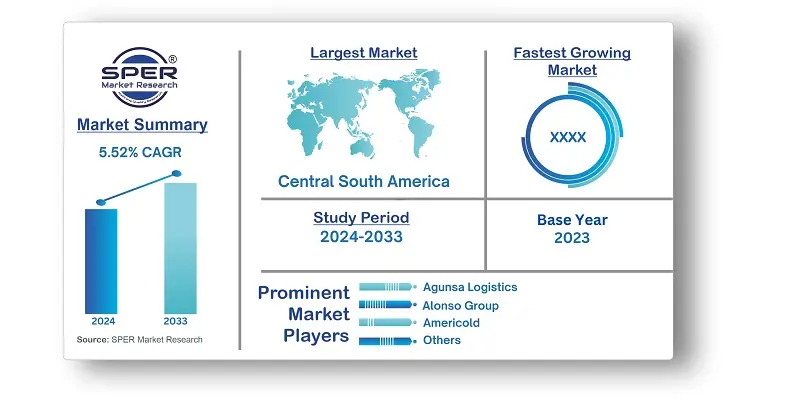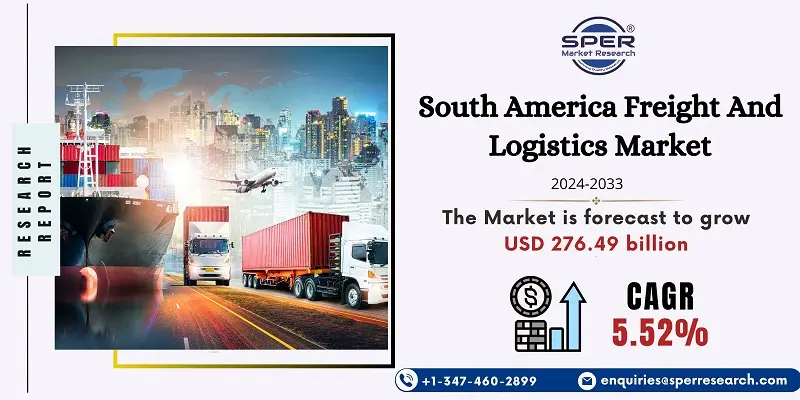
South America Freight And Logistics Market Growth, Size, Trends, Share and Future Competition
South America Freight And Logistics Market Size- By End User, By Logistics Function- Regional Outlook, Competitive Strategies and Segment Forecast to 2033
| Published: Mar-2024 | Report ID: AMIN2477 | Pages: 1 - 158 | Formats*: |
| Category : Automotive & Transportation | |||
- November 2022: DHL extended for an additional four years its cooperation with the German Bobsleigh, Luge, and Skeleton Federation (BSD). Since the winter of 2014–2015, a premium and logistics relationship has been in place. It covers the branding of athletes' apparel and sports equipment as well as the logistics of all equipment used over the seasons.
- In November 2022: DP World signed a memorandum of understanding (MOU) to help trade growth and logistics at the Lin-Gang Special Area, a free trade zone in Shanghai, therefore expanding its activities in China.


| Report Metric | Details |
| Market size available for years | 2020-2033 |
| Base year considered | 2023 |
| Forecast period | 2024-2033 |
| Segments covered | By End User, By Logistics Function |
| Regions covered | Argentina, Brazil, Chile, Rest of South America |
| Companies Covered | Agunsa Logistics, Alonso Group, Americold, CMA CGM, DB Schenker, Deutsche Post DHL Group, DP World, DSV A/S (De Sammensluttede Vognmænd af Air and Sea), Kuehne + Nagel, SAAM, TASA LogÃstica, Others. |
- Manufacturers and Producers
- Retailers and Wholesalers
- E-commerce Companies
- Transportation Companies
- Government Agencies
- Investors and Financial Institutions
- Supply Chain Managers and Professionals
- International Trade Organizations
- Technology Providers
- Consumers
- Others
| By End User: |
|
| By Logistics Function: |
|
| By Region: |
|
- South America Freight And Logistics Market Size (FY’2024-FY’2033)
- Overview of South America Freight And Logistics Market
- Segmentation of South America Freight And Logistics Market By End User (Agriculture, Fishing and Forestry, Construction, Manufacturing, Oil and Gas, Mining and Quarrying, Wholesale and Retail Trade, Others)
- Segmentation of South America Freight And Logistics Market By Logistics Function (Courier, Express and Parcel, Freight Forwarding, Freight Transport, Warehousing and Storage)
- Expansion Analysis of South America Freight And Logistics Market
- Problems and Obstacles in South America Freight And Logistics Market
- Competitive Landscape in the South America Freight And Logistics Market
- Impact of COVID-19 and Demonetization on South America Freight And Logistics Market
- Details on Current Investment in South America Freight And Logistics Market
- Competitive Analysis of South America Freight And Logistics Market
- Prominent Players in the South America Freight And Logistics Market
- SWOT Analysis of South America Freight And Logistics Market
- South America Freight And Logistics Market Future Outlook and Projections (FY’2024-FY’2033)
- Recommendations from Analyst
1.1. Scope of the report1.2. Market segment analysis
2.1. Research data source2.1.1. Secondary Data2.1.2. Primary Data2.1.3. SPER’s internal database2.1.4. Premium insight from KOL’s2.2. Market size estimation2.2.1. Top-down and Bottom-up approach
2.3. Data triangulation
4.1. Driver, Restraint, Opportunity and Challenges analysis4.1.1. Drivers4.1.2. Restraints4.1.3. Opportunities4.1.4. Challenges
4.2. COVID-19 Impacts of the South America Freight And Logistics Market
5.1. SWOT Analysis5.1.1. Strengths5.1.2. Weaknesses5.1.3. Opportunities5.1.4. Threats5.2. PESTEL Analysis5.2.1. Political Landscape5.2.2. Economic Landscape5.2.3. Social Landscape5.2.4. Technological Landscape5.2.5. Environmental Landscape5.2.6. Legal Landscape5.3. PORTER’s Five Forces5.3.1. Bargaining power of suppliers5.3.2. Bargaining power of buyers5.3.3. Threat of Substitute5.3.4. Threat of new entrant5.3.5. Competitive rivalry
5.4. Heat Map Analysis
6.1. South America Freight And Logistics Market Manufacturing Base Distribution, Sales Area, Product Type6.2. Mergers & Acquisitions, Partnerships, Product Launch, and Collaboration in South America Freight And Logistics Market
7.1. South America Freight And Logistics Market Value Share and Forecast, By End User, 2024-20337.2. Agriculture, Fishing and Forestry7.3. Construction7.4. Manufacturing7.5. Oil and Gas, Mining and Quarrying7.6. Wholesale and Retail Trade7.7. Others
8.1. South America Freight And Logistics Market Value Share and Forecast, By Logistics Function, 2024-20338.2. Courier, Express and Parcel8.2.1. Destination Type8.2.1. Domestic8.2.1. International8.3. Freight Forwarding8.3.1. Mode of Transport8.3.1. Air8.3.1. Sea and Inland Waterways8.3.1. Others8.4. Freight Transport8.4.1. Mode of Transport8.4.1. Air8.4.1. Pipelines8.4.1. Rail8.4.1. Road8.4.1. Sea and Inland Waterways8.5. Warehousing and Storage8.5.1. Temperature Control8.5.1. Non-Temperature Controlled8.5.1. Temperature Controlled
9.1. South America Freight And Logistics Market Size and Market Share
10.1. South America Freight And Logistics Market Size and Market Share By End User (2020-2026)10.2. South America Freight And Logistics Market Size and Market Share By End User (2027-2033)
11.1. South America Freight And Logistics Market Size and Market Share By Logistics Function (2020-2026)11.2. South America Freight And Logistics Market Size and Market Share By Logistics Function (2027-2033)
12.1. South America Freight And Logistics Market Size and Market Share By Region (2020-2026)12.2. South America Freight And Logistics Market Size and Market Share By Region (2027-2033)12.3. Argentina12.4. Brazil12.5. Chile12.6. Rest of South America
13.1. Agunsa Logistics13.1.1. Company details13.1.2. Financial outlook13.1.3. Product summary13.1.4. Recent developments13.2. Alonso Group13.2.1. Company details13.2.2. Financial outlook13.2.3. Product summary13.2.4. Recent developments13.3. Americold13.3.1. Company details13.3.2. Financial outlook13.3.3. Product summary13.3.4. Recent developments13.4. CMA CGM13.4.1. Company details13.4.2. Financial outlook13.4.3. Product summary13.4.4. Recent developments13.5. DB Schenker13.5.1. Company details13.5.2. Financial outlook13.5.3. Product summary13.5.4. Recent developments13.6. Deutsche Post DHL Group13.6.1. Company details13.6.2. Financial outlook13.6.3. Product summary13.6.4. Recent developments13.7. DP World13.7.1. Company details13.7.2. Financial outlook13.7.3. Product summary13.7.4. Recent developments13.8. DSV A/S (De Sammensluttede Vognmænd af Air and Sea)13.8.1. Company details13.8.2. Financial outlook13.8.3. Product summary13.8.4. Recent developments13.9. Kuehne + Nagel13.9.1. Company details13.9.2. Financial outlook13.9.3. Product summary13.9.4. Recent developments13.10. Kuehne + Nagel13.10.1. Company details13.10.2. Financial outlook13.10.3. Product summary13.10.4. Recent developments13.11. SAAM13.11.1. Company details13.11.2. Financial outlook13.11.3. Product summary13.11.4. Recent developments13.12. TASA LogÃstica13.12.1. Company details13.12.2. Financial outlook13.12.3. Product summary13.12.4. Recent developments13.13. Others
SPER Market Research’s methodology uses great emphasis on primary research to ensure that the market intelligence insights are up to date, reliable and accurate. Primary interviews are done with players involved in each phase of a supply chain to analyze the market forecasting. The secondary research method is used to help you fully understand how the future markets and the spending patterns look likes.
The report is based on in-depth qualitative and quantitative analysis of the Product Market. The quantitative analysis involves the application of various projection and sampling techniques. The qualitative analysis involves primary interviews, surveys, and vendor briefings. The data gathered as a result of these processes are validated through experts opinion. Our research methodology entails an ideal mixture of primary and secondary initiatives.



Frequently Asked Questions About This Report
PLACE AN ORDER
Year End Discount
Sample Report
Pre-Purchase Inquiry
NEED CUSTOMIZATION?
Request CustomizationCALL OR EMAIL US
100% Secure Payment






Related Reports
Our Global Clients
Our data-driven insights have influenced the strategy of 200+ reputed companies across the globe.




















